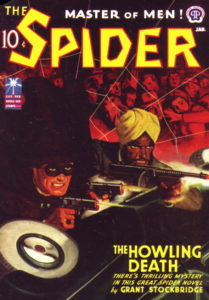
“The Howling Death” was originally published in the January 1943 issue of The Spider Magazine. The Spider found a city mad with terror, its population fighting each other to escape the mysterious death that turned humans into screaming, howling maniacs.
Here’s another top-notch Spider adventure. It’s the war-years, and The Spider adventures had lost none of their steam. The action still comes fast and furious. The perils that strike an unsuspecting populace are widespread and terrible. And when The Spider shoots, there are no wounded thugs left behind. Instead, they lay with a bullet hole in the center of their foreheads. One of the things that makes this story stand out, in addition to the gruesome Howling Death, is that Nita van Sloan really gets to shine, here. And for that reason, even if for no other, this story gets a strong recommendation.
In this tale, it’s not Manhattan that is put in peril, as is typical of so many Spider stories. This one takes place mostly in the war factory town of Center. It’s location isn’t specified, but in my mind it might be in Ohio, where so many war factories were located. It’s in Center where most of the Howling Deaths take place. But there are also those bizarre death in Epsom, a near-by town with competing war factories. And the Howling Death also visits Joliet, Ill., where the penitentiary is located. Manhattan, somehow, escapes unscathed this time around.
What is the Howling Death?
Just what is this Howling Death? A person infected finds it difficult to breath. His breath comes in whines, then spasms into howls… and then comes death after several torturous minutes.
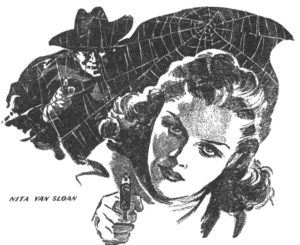
The first such death occurred in Epsom, where factories produced war materials non-stop. Nita van Sloan reads of them in the newspapers and notifies her boyfriend Richard Wentworth. Wentworth is out of the country, doing government work in Brazil. Since he won’t be able to return for a week, Nita takes it upon herself to go to Epsom and investigate the strange deaths.
As a note of interest, it seems that during war time, censors listened in to international phone calls. Nothing secret or surreptitious, here. It was a commonly accepted practice. So, because of the listeners, Wentworth has to be careful what he says, when speaking with Nita.
Nita tries to get a job in one of the war factories in Epsom, but fails. She get a job in the nearby town of Center, instead. She’s an inspector of airplane propeller shafts. And it’s a good thing her job is in Center, because that’s where the Howling Death is about to strike in all its fury.
Nita goes to visit a young woman and fellow factory worker, Anne Batchelor. Anne has seem some suspicious things. But before Nita can speak with her, the Howling Death claims another victim. Nita engages in a gun battle with two thugs who have booby trapped Anne’s apartment, and shoots one of them dead center (no pun intended) in the forehead. Nita’s a fearless fighter, and this is the first of many she kills in this story. Not the kind of girl you want to mess around with!
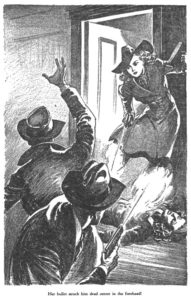
Nita leaves the scarlet seal of The Spider on the wall by the corpse. She uses the silver pencil that was featured predominantly for about a year, to make that mark. And, hey, kids, you too can get one of these terrific Spider pencils! Yes, it was a promotional giveaway from Popular Publications. Send in a quarter and get a pencil with a spider rubber stamp on the eraser end. So for a year or so, the cigarette lighter was downplayed as the source of the scarlet seal. It was the silver pencil that was touted for creating the seal of The Spider.
Of course, as Nita escapes the apartment house by the back fire escape, she’s captured by the gang. But meanwhile…
Richard Wentworth returns
Richard Wentworth finally returns to the USA. He secretly rushes to Center and prepares to flush out the killers at the war factory. His plan backfires, and Stanley Critton, vice president of Federated Motors Co., is stricken with the Howling Death. And a strange list of names is taken from his desk drawer.
Once the reader knows how the Howling Death is accomplished, some of these deaths don’t make sense. Of course we don’t know that at the time. It’s only in hindsight that we realize things don’t quite mesh. Like the death of factory vice president Stanley Critton. He dies, but how did he get infected? I guess it’s one of those loopholes that we weren’t supposed to notice. And the action comes to quickly, that it’s easy to over look these things. And maybe it’s just better that way.
There are some interesting parallels that we can see in the descriptions of The Spider, when we compare them with one of his pulp contemporaries, The Shadow. Both used black to hide themselves in the depths of the shadows, as this passage illustrates: “He stepped past Stanley Critton’s desk and the shadow behind the filing cabinet received him. It was possible then to see why he wore the apparently fantastic costume of The Spider. It blurred his outline, so that he seemed to melt invisibly into the shadows.” Boy, that could almost have been taken verbatim from a Shadow pulp.
As the story continues, things get worse and worse… and worse. Pretty soon people are dropping like flies. Panic floods the streets. Even the President of the United States gets involved! Yes, Richard Wentworth has been working for the President down in Brazil, and when he makes his report, along with him comes the contagion known as the Howling Death. Luckily the President escapes, but it certainly doesn’t make Richard Wentworth very popular with the Secret Service.
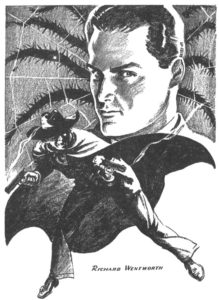
We’re told that the Master of the Howling Death is intent upon discrediting Wentworth. So he sows death about him, to make it appear that Wentworth is spreading it. Which raises the question, how does this mystery man know that Wentworth is The Spider? It seems in all these stories, the chief baddie goes after Wentworth, knowing he is The Spider. How is it the bad guys always know the secret identity of The Spider, but the good guys never catch on?
And what about poor Nita? Remember, she had been captured. But Richard Wentworth tracks her down and rescues her. In the process he encounters a truly exceptional death trap. I always enjoy reading those scenes, to see what clever method The Spider will use to escape the seemingly inescapable traps. This particular one involves a room with three exits. And all have been booby trapped with the Howling Death. Whichever way he chooses, he chooses death.
Escape from certain death
How does he escape? He breaks a hole in the ceiling. He figures the room above is also infected with the Howling Death poison. Then, “Swiftly, The Spider used fluid from his cigarette lighter to ignite the splintered ends of the boards he had broken through. Whether the Howling Death was caused by poison gas, or by poison in some other form did not matter. If it were gas, the draft of the flames would disperse it; if it were poison, the heat of the fire would destroy it.” At least that’s how the story explains it.
But wait a minute. Why bother breaking a hole in the ceiling at all? He could have used the same method on any of the three booby-trapped exits. I think we were cheated, here. But try not to think this stuff through too carefully, and you’ll probably enjoy it more.
Wentworth gets to use a lot of disguises in this story. He’s a master of disguise, and gets to show off his skill, here. He demonstrates his incredible voice mimicry as he impersonates the chief of the Secret Service. All to escape, after the attempt on the President’s life. He also becomes Eric Birkstadt, a 58-year-old Scandinavian factory worker. It’s interesting to note that Wentworth says in character as long as he wears his disguise. Even when he is alone with Nita he still uses his Scandinavian accent as Eric Birkstadt.
In this tale, when Wentworth disguises himself as The Spider, that guise doesn’t include his deformed face or snaggly teeth. When he visits the factory owner, he lifts his head and the light strikes him full on the face. The only thing the man notices is the imperiousness of his gray-blue eyes.
Another note of interest. The Spider keeps secret caches scattered throughout the city: “The Spider had established fully a dozen depots for equipment, money, arsenals and cars about the city. At irregular intervals, he would abandon various ones, shift to other places. Once he had prepared elaborate strongholds, secretly guarded, with special escape routes. More than once, they had been found and turned into almost-fatal traps. So, nowadays, he changed them often, and only made sure that there were at least two ways in and out of everyone.” Yes, when you’re The Spider, you can’t afford not to be too careful.
Technology – 1940s style
I also caught a fascinating reference to the old technology of wire recorders. We’re told that Wentworth often leaves phone messages for Ram Singh on a wire recorder. Those messages are spoken in Punjab, difficult for any one else to understand. After Ram Singh hears the recorded message, he passes a magnet over the wire and the message is gone. These machines were quite rare at the time, and their usage was mostly limited to the military during the war. An early telephone answering system… voice mail of the 1940s!
The Spider also has a portable broadcasting system which he has Ram Singh use in this story to broadcast a warning to factory workers about an upcoming attack. Ah, the gadgets these guys had!
When things really heat up near the end, the bad guys attack Joliet Prison with a white vapor that carries the Howling Death. Over 250 criminals escape. Fifty die from the Howling Death and another hundred are caught or killed. But that still leaves over a hundred hardened criminals on the loose. There is a crime wave! Cars were stolen, robberies committed, people kidnapped and killed, terror was loose in Joliet.
More die. Hundreds! And thousands in the city of Center are doomed, when the city is quarantined, and armed soldiers force them to stay within those infected boundaries. This is a job for The Spider!
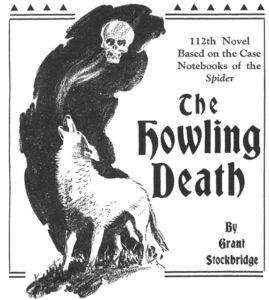
So what is this Howling Death, exactly. The story explains a bit vaguely, “The poison causes a spasmodic constriction that forces whining howls from the throat.” And that’s all we get. But there’s no explanation of where it came from or how the criminal mastermind got his hands upon it. It’s just there. And when the story ends, the nagging question remains, what about the stockpiles of the poison left behind hidden somewhere. It’s one of troubling loose ends that we find all so often in pulp tales. So, get used to it!
There’s plenty of flag-waving and patriotism in this war-time story. You can really tell that it was wartime from the constant references to the quality of our fighting forces and heinous acts of our enemies.
The story really invokes emotions, really tugs at the heartstrings. I must admit, it brought a tear to my eye to read the climax where citizens calmly walk through the lines of the soldiers who imprison them, holding a cross and singing Christmas hymns.
No one trusts anyone
This is another story with a strong paranoia quotient. Actions are always misconstrued. When a dying man gestures at Wentworth, police interpret it as an accusation that he is the killer. It seems no one trusts anyone…
No sign of Jenkyns or Jackson in this story, but as mentioned earlier, this is largely a Nita van Sloan story. Wentworth is often not present, and she gets plenty of action in this tale. Nita is the one who battles the thugs and saves the day. She really shows off her fighting abilities.
It makes for a thrilling battle against the foul powers of evil. It’s a lot of fun, and will keep you on the edge of your seat. A good one to read!

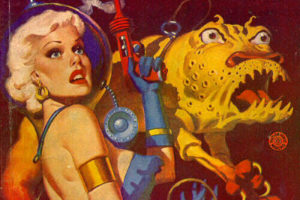
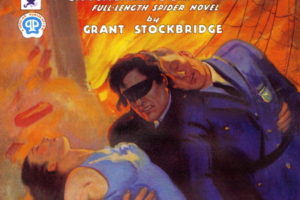
John-
I just picked up your “The Shadow in Review” from Lulu and was amazed at how thorough a job you’ve done. And at such an affordable price. I hope the word is getting out (I’m spreading it to the people I know who love these things) and, further, that you may tackle The Spider (my favorite pulp character) in the same way. A job very well done!
Hi Pete! (I’m going to call you Pete, but if I’m getting presumptuous, just slap me down.)
Thanks for the kind words on my new book. Making it affordable was one of my goals. I wanted it to be available to as many people as possible. So the price is basically just the printing costs and shipping.
The Spider is a favorite of mine, too. Kinda like The Shadow on steroids. But I doubt if I’ll put out a book of reviews on the Spider. It would make a much thinner book, for one thing. There are only 118 Spider stories, compared to the 325 Shadow tales.
You can still count on seeing reviews of the Spider stories here on my blog every now and then. They are really great, aren’t they!
(One difference between the Spider and The Shadow: the word “the” isn’t capitalized for the Spider. Strange, eh?)